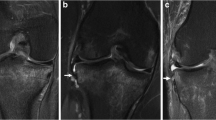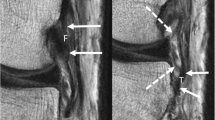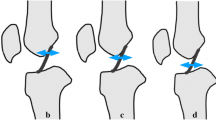Abstract
Objective
Anterior cruciate ligament tears are frequent and if not diagnosed may lead to relevant patient disability. Magnetic resonance imaging is the method of choice for the non-invasive diagnosis of these tears. Despite the high performance of this method some cases are challenging and the criteria described in the literature are not sufficient to reach a diagnosis. We propose a systematic method for the evaluation of anterior cruciate ligament tears based on the aspect of its distal portion.
Materials and methods
Magnetic resonance studies of 132 knees were evaluated in correlation with arthroscopy. The performance of the proposed method was compared with that of classic imaging signs of anterior cruciate ligament tear. The impact of image quality and reader expertise on the proposed method and the classic signs of tear were taken into account.
Results
This method had a sensitivity and specificity of 91.1% and 82.9% for the detection of abnormal ACLs. The interobserver agreement (kappa) of the proposed method was significantly higher than that of the classic signs at all levels of expertise (0.89 vs 0.76). This method was not influenced by image quality. Distal ACL analysis identified more partial tears and synovialization (granulation scar tissue) than the conventional method (71% vs 58.5% for partial tears and 83.5% vs 58.5% for synovialization).
Conclusion
The proposed classification has a high performance and reproducibility for the identification of abnormal anterior cruciate ligament. The results were influenced neither by the level of expertise of the readers nor by the image quality.








Similar content being viewed by others
References
Palle L, Reddy B, Reddy J. Sensitivity and specificity of vertically oriented lateral collateral ligament as an indirect sign of anterior cruciate ligament tear on magnetic resonance imaging. Skeletal Radiol. 2010;39:1123–7.
Clayton RA, Court-Brown CM. The epidemiology of musculoskeletal tendinous and ligamentous injuries. Injury. 2008;39:1338–44.
Tandogan RN, Taser O, Kayaalp A, Taskiran E, Pinar H, Alparslan B, et al. Analysis of meniscal and chondral lesions accompanying anterior cruciate ligament tears: relationship with age, time from injury, and level of sport. Knee Surg Sports Traumatol Arthrosc. 2004;12:262–70.
Rayan F, Bhonsle S, Shukla DD. Clinical, MRI, and arthroscopic correlation in meniscal and anterior cruciate ligament injuries. Int Orthop. 2009;33:129–32.
Kocabey Y, Tetik O, Isbell WM, Atay OA, Johnson DL. The value of clinical examination versus magnetic resonance imaging in the diagnosis of meniscal tears and anterior cruciate ligament rupture. Arthroscopy. 2004;20:696–700.
Kim A, Khoury L, Schweitzer M, Jazrawi L, Ishak C, Meislin R, et al. Effect of specialty and experience on the interpretation of knee MRI scans. Bull NYU Hosp Jt Dis. 2008;66:272–5.
Krampla W, Roesel M, Svoboda K, Nachbagauer A, Gschwantler M, Hruby W. MRI of the knee: how do field strength and radiologist’s experience influence diagnostic accuracy and interobserver correlation in assessing chondral and meniscal lesions and the integrity of the anterior cruciate ligament? Eur Radiol. 2009;19:1519–28.
Robertson PL, Schweitzer ME, Bartolozzi AR, Ugoni A. Anterior cruciate ligament tears: evaluation of multiple signs with MR imaging. Radiology. 1994;193:829–34.
Brandser EA, Riley MA, Berbaum KS, el-Khoury GY, Bennett DL. MR imaging of anterior cruciate ligament injury: independent value of primary and secondary signs. AJR Am J Roentgenol. 1996;167:121–6.
Tung GA, Davis LM, Wiggins ME, Fadale PD. Tears of the anterior cruciate ligament: primary and secondary signs at MR imaging. Radiology. 1993;188:661–7.
Mellado JM, Calmet J, Olona M, Gine J, Sauri A. Magnetic resonance imaging of anterior cruciate ligament tears: reevaluation of quantitative parameters and imaging findings including a simplified method for measuring the anterior cruciate ligament angle. Knee Surg Sports Traumatol Arthrosc. 2004;12:217–24.
McCauley TR, Moses M, Kier R, Lynch JK, Barton JW, Jokl P. MR diagnosis of tears of anterior cruciate ligament of the knee: importance of ancillary findings. AJR Am J Roentgenol. 1994;162:115–9.
Van Dyck P, Gielen JL, Vanhoenacker FM, Wouters K, Dossche L, Parizel PM. Stable or unstable tear of the anterior cruciate ligament of the knee: an MR diagnosis? Skeletal Radiol. 2011. doi:10.1007/s00256-011-1169-4.
Van Dyck P, Vanhoenacker FM, Gielen JL, Dossche L, Van Gestel J, Wouters K, et al. Three Tesla magnetic resonance imaging of the anterior cruciate ligament of the knee: can we differentiate complete from partial tears? Skeletal Radiol. 2011;40:701–7.
Kwon JW, Yoon YC, Kim YN, Ahn JH, Choe BK. Which oblique plane is more helpful in diagnosing an anterior cruciate ligament tear? Clin Radiol. 2009;64:291–7.
Petersen W, Zantop T. Partial rupture of the anterior cruciate ligament. Arthroscopy. 2006;22:1143–5.
Katahira K, Yamashita Y, Takahashi M, Otsuka N, Koga Y, Fukumoto T, et al. MR imaging of the anterior cruciate ligament: value of thin slice direct oblique coronal technique. Radiat Med. 2001;19:1–7.
Lawrance JA, Ostlere SJ, Dodd CA. MRI diagnosis of partial tears of the anterior cruciate ligament. Injury. 1996;27:153–5.
Chen WT, Shih TT, Tu HY, Chen RC, Shau WY. Partial and complete tear of the anterior cruciate ligament. Acta Radiol. 2002;43:511–6.
Roychowdhury S, Fitzgerald SW, Sonin AH, Peduto AJ, Miller FH, Hoff FL. Using MR imaging to diagnose partial tears of the anterior cruciate ligament: value of axial images. AJR Am J Roentgenol. 1997;168:1487–91.
Higueras Guerrero V, Torregrosa Andres A, Marti-Bonmati L, Casillas C, Sanfeliu M. Synovialisation of the torn anterior cruciate ligament of the knee: comparison between magnetic resonance and arthroscopy. Eur Radiol. 1999;9:1796–9.
Roberts CC, Towers JD, Spangehl MJ, Carrino JA, Morrison WB. Advanced MR imaging of the cruciate ligaments. Magn Reson Imaging Clin N Am. 2007;15:73–86.
Sonnery-Cottet B, Barth J, Graveleau N, Fournier Y, Hager JP, Chambat P. Arthroscopic identification of isolated tear of the posterolateral bundle of the anterior cruciate ligament. Arthroscopy. 2009;25:728–32.
Huang GS, Lee CH, Chan WP, Lee HS, Chen CY, Yu JS. Acute anterior cruciate ligament stump entrapment in anterior cruciate ligament tears: MR imaging appearance. Radiology. 2002;225:537–40.
Cobby MJ, Schweitzer ME, Resnick D. The deep lateral femoral notch: an indirect sign of a torn anterior cruciate ligament. Radiology. 1992;184:855–8.
Blum A, Feldmann L, Bresler F, Jouanny P, Briancon S, Regent D. Value of calculation of the kappa coefficient in the evaluation of an imaging method. J Radiol. 1995;76:441–3.
Panisset JC, Duraffour H, Vasconcelos W, Colombet P, Javois C, Potel JF, et al. [Clinical, radiological and arthroscopic analysis of the ACL tear. A prospective study of 418 cases]. Rev Chir Orthop Reparatrice Appar Mot. 2008;94:362–8.
Poellinger A, Scheffler S, Hamm B, Asbach P. Magnetic resonance imaging of double-bundle anterior cruciate ligament reconstruction. Skeletal Radiol. 2009;38:309–15.
Remer EM, Fitzgerald SW, Friedman H, Rogers LF, Hendrix RW, Schafer MF. Anterior cruciate ligament injury: MR imaging diagnosis and patterns of injury. Radiographics. 1992;12:901–15.
Buckwalter KA, Pennes DR. Anterior cruciate ligament: oblique sagittal MR imaging. Radiology. 1990;175:276–7.
Murao H, Morishita S, Nakajima M, Abe M. Magnetic resonance imaging of anterior cruciate ligament (ACL) tears: diagnostic value of ACL-tibial plateau angle. J Orthop Sci. 1998;3:10–7.
Ben Hamida F, Mourali S, Ben Lakhdar Z, Hadjsalah M. [Anatomical risk factors for anterior cruciate-ligament rupture. Comparative study]. J Traumatol Sport. 2008;25:144–7.
Hohmann E, Bryant A, Reaburn P, Tetsworth K. Does posterior tibial slope influence knee functionality in the anterior cruciate ligament-deficient and anterior cruciate ligament-reconstructed knee? Arthroscopy. 2010;26:1496–502.
Barry KP, Mesgarzadeh M, Triolo J, Moyer R, Tehranzadeh J, Bonakdarpour A. Accuracy of MRI patterns in evaluating anterior cruciate ligament tears. Skeletal Radiol. 1996;25:365–70.
Tavernier T, Cotten A. High- versus low-field MR imaging. Radiol Clin N Am. 2005;43:673–81.
Sanal HT, Cardoso F, Chen L, Chung C. Office-based versus high-field strength MRI: diagnostic and technical considerations. Sports Med Arthrosc. 2009;17:31–9.
Kijowski R, Davis KW, Woods MA, Lindstrom MJ, De Smet AA, Gold GE, et al. Knee joint: comprehensive assessment with 3D isotropic resolution fast spin-echo MR imaging—diagnostic performance compared with that of conventional MR imaging at 3.0 T. Radiology. 2009;25:486–95.
Nishikawa H, Imanaka Y, Sekimoto M, Ikai H. Verification bias in assessment of the utility of MRI in the diagnosis of cruciate ligament tears. AJR Am J Roentgenol. 2010;195:W357–64.
Acknowledgements
We wish to thank Professor Coudane (ATOL, CHU Nancy) for his assistance and his advice in the writing of this manuscript.
Conflict of interest
The authors declare that they have no conflict of interest.
Author information
Authors and Affiliations
Corresponding author
Additional information
The two first authors have worked in equal measure on the production of this manuscript and we hereby request a joint first authorship
Rights and permissions
About this article
Cite this article
Oldrini, G., Teixeira, P.G., Chanson, A. et al. MRI appearance of the distal insertion of the anterior cruciate ligament of the knee: an additional criterion for ligament ruptures. Skeletal Radiol 41, 1111–1120 (2012). https://doi.org/10.1007/s00256-012-1363-z
Received:
Revised:
Accepted:
Published:
Issue Date:
DOI: https://doi.org/10.1007/s00256-012-1363-z




